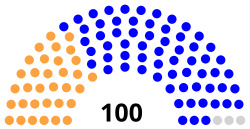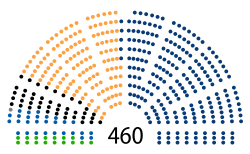Parliament of Poland
|
Parliament of Poland Parlament Rzeczypospolitej Polskiej |
|
|---|---|
 |
|
| Type | |
| Type | |
| Houses | |
|
Term limits
|
4 years |
| Leadership | |
| Structure | |
| Seats | |
 |
|
|
Senate political groups
|
Government (64)
|
 |
|
|
Sejm political groups
|
|
| Elections | |
| First-past-the-post voting | |
| Proportional representationa | |
|
Senate last election
|
6 March 2016 |
|
Sejm last election
|
25 October 2015 |
|
Senate next election
|
No later than 25 October 2019 |
|
Sejm next election
|
No later than 25 October 2019 |
| Meeting place | |
 |
|
| Sejm building, Warsaw | |
| Footnotes | |
| aOpen-list proportional representation in 41 constituencies (5% national election threshold, 8% national election threshold for coalitions). | |
Government (64)
The parliament of Poland has an upper house, the Senate, and a lower house, the Sejm. Both houses are accommodated by the Sejm complex in Warsaw. The parliament itself is without an official name; the Constitution of Poland refers only to the Sejm and the Senate.
Members of both houses are elected by direct election, usually every four years. The Sejm has 460 members, while the Senate has 100 senators. To become law, a bill must first be approved by both houses, but the Sejm can override a Senate refusal to pass a bill.
On certain occasions, the Marshal of the Sejm summons the National Assembly, a joint sessiin the members of both houses of parliament. Its function is mostly ceremonial in nature, and it convenes only occasionally, such as to witness the inauguration of the President. Under exceptional circumstances, the constitution endows the National Assembly with significant responsibilities, such as the power to bring the President before the State Tribunal (impeachment).The leading party is Law and Justice (PiS) with 234 out of 460 seats in Sejm and 61 out of 100 seats in Senate. Debating halls have designated seats for the deputies, senators and the Marshal. Seats are also equipped in voting devices, used by deputies and senators to vote.
...
Wikipedia
